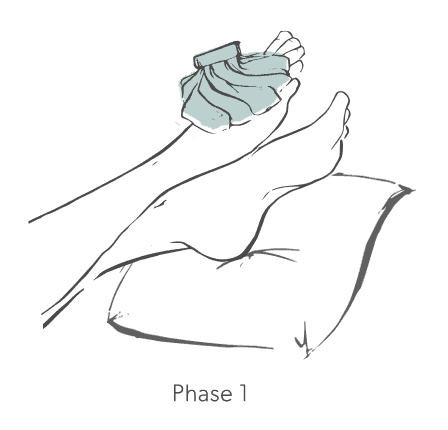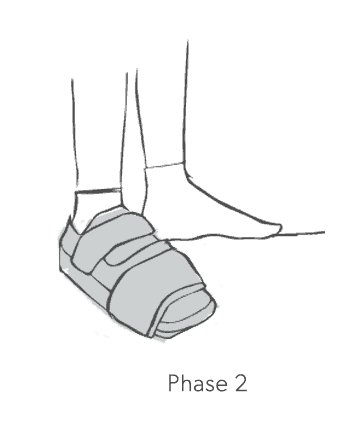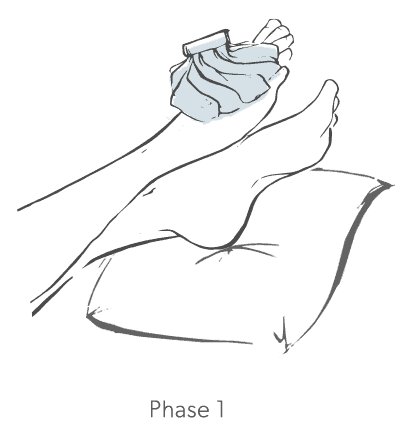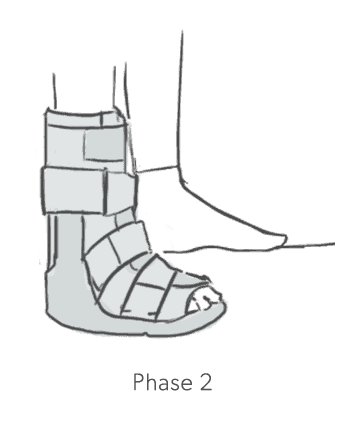Recovery
You picked the right surgeon, the procedure is done, now it’s time to put your feet up. Relax─ recovery from bunion surgery is not as bad as you think.
Recovery
What’s the recovery like?
After the surgeon has completed the procedure (a typical Austin type surgery is only 30-40 minutes long) you will wake up from the sedation and/or anesthesia in a Recovery Room.
During the operation, the surgeon will have administered a pain block so you won’t be able to feel anything in your foot.
Your foot will be in a post-op surgical shoe. If your toes are exposed, you may be able to see that they’re now aligned correctly, no longer overlapping if they were before. You will be able to walk with a cane or crutches to the car.
BUNION FACT # 88
An Austin bunionectomy can fix around 70% of bunions.
Recovery 1
Applies to the Austin bunionectomy, Cheilectomy, Implant Arthroplasty and Joint Fusion

Phase 1: The first 72 hours
Keep feet elevated on pillows above the knees, to avoid swelling.
You can ice your ankles or the sides of foot, though they will be wrapped in surgical bandages. The pain block will last 12-36 hours getting you over the “pain hump”; once the block wears off, your doctor will suggest you take either an over-the-counter painkiller or the one he prescribed. Most people take painkillers for 12-24 hours to stay ahead of the pain. You will also take the antibiotic prescription you had filled to protect against infection. You can get up and walk to the bathroom with the cane, but the rest of the time you are on the couch with your feet up.
Phase 2: The first 2 weeks
After the first 72 hours, you will be able to walk around with a cane, shower, go outside and even drive after a few more days if you feel like it.
You will be wearing post-op shoes for two weeks. You may or may not need a painkiller. Doctors suggest you keep your feet elevated when sitting, but definitely encourage you to get up and move around. Take showers with the waterproof shower protector over your foot, which should not get wet.


Phase 3: After 2 weeks and beyond
Your doctor will remove the stitches after two weeks (and yes, you will be able to get a really good idea of what your feet will look like once healed.)
The doctor may or may not wrap your feet in soft bandages. After the stitches are out, you can usually get your feet wet in the shower a few days later. At this point, depending on what the doctor says, you should be able to trade in the post-op shoes for supportive sneakers or Crocs, or if the weather is warm enough, supportive sandals. You might need to buy a size up to accommodate the bandages. Wear these shoes for the next 4-5 weeks. You will continue to heal for the next few months.
You can resume normal exercise at 3-4 weeks and by 6 weeks the bone will be stable enough to run on. You should be able to wear most heels in 3-6 months, but your feet will continue to heal for up to a year. The scar, either on the side of your foot or on top, will continue to fade till it’s practically unnoticeable, depending on how your body heals.
Recovery 2
Applies to the Lapidus procedure

Phase 1: The first 72 hours
Keep feet elevated on pillows, above the knees, to avoid swelling.
You can ice your ankles or the sides of foot, though they will be wrapped in surgical bandages. The pain block will last 12-36 hours getting you over the “pain hump”; once the block wears off, your doctor will suggest you take either an over-the-counter painkiller or the one he prescribed. Most people take painkillers for 12-24 hours to stay ahead of the pain. You will also take the antibiotic prescription you had filled to protect against infection. You can get up and walk to the bathroom with the cane, but the rest of the time you are on the couch with your feet up.
Phase 2: The first 6-7 weeks
You will wear a post-op surgical boot for 6-7 weeks
The current thinking among a majority of surgeons is to put weight on your foot while in the boot. Around two weeks after your surgery, the doctor will remove the stitches, after which you can get your foot wet in the shower. You cannot have the Lapidus procedure done on both feet at once, and you won’t be able to drive if it’s your right foot.


Phase 3: Beyond 7 weeks
It will take around 8 to 10 weeks before you can completely resume to normal activities.
Because the Lapidus procedure involves your bones fusing together at the metatarsal cuneiform joint in the middle of your foot, healing takes longer than with the Austin, meaning up to 8 to 10 weeks before completely resuming normal activities. That said, there should not be any problem with returning to normal exercise such as running and walking once the foot is healed. An X-ray in the doctor’s office will let him or her know how well the bones are fusing together.
Bunion Fact # 36
Ultimately, only your doctor can provide you with specific recovery information for your procedure.
Recovery
How much pain will I really be in?
Everyone always asks the most questions about pain.
It’s another longstanding myth that bunion surgery in incredibly painful. It’s not.
As long as you’re in the hands of an experienced bunion surgeon. According to those who perform the most bunionectomies, 50% of patients operated on by an experienced bunion surgeon don’t feel any pain. The other 50% experience discomfort that is almost always controlled with oral pain medication. Extreme pain is rare.
The part of the myth that is based on some truth is that if you go to a surgeon who only dabbles in bunion surgery, they are not as proficient in performing bunion surgery. They may take longer to operate, which can result in more tissue trauma and swelling, and therefore more pain. An experienced bunion surgeon who has performed thousands of these surgeries will know which procedure is right for you and then perform it efficiently with a knowledge and comfort of exactly what he or she is doing. They will know exactly how to administer long-acting anesthetics. The operating time is shorter, so there’s less tissue trauma, less swelling, and less pain. For the most part, the amount of pain you experience, if any at all, directly correlates to the experience of the surgeon in correcting bunions.
During the first 72 hours of recovery, how your body metabolizes anesthesia–and therefore when the pain block wears off–will determine when you start to feel your foot, usually 12-36 hours after the operation. After that initial phase, pain is minimal if it exists at all.
The side effect that sometimes is overshadowed by surgery preparation and recovery, is the joy you will experience in having had bunion surgery, and seeing the results. After years of looking at your foot and feeling embarrassment or even shame, finally you will see your feet and feel something new–pride.
